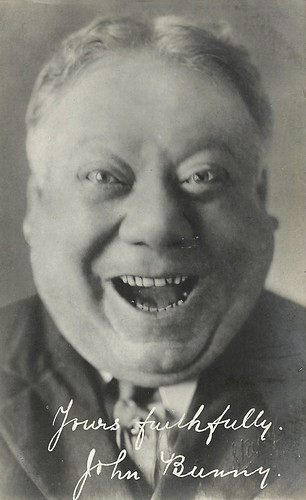
British postcard. Caption: John Bunny of the Vitagraph Players in character.

British postcard.
An extensive and extremely flexible face
John Bunny was born in New York City, N.Y., in 1863. He was the ninth in a line of English sea captains and would be the first not to follow in that profession. He grew up in Brooklyn, where he attended St. James High School and worked as a grocery store clerk before joining a small minstrel show that toured the West Coast.
He appeared in musical comedies such as 'Old Dutch' with Hattie Williams and Lew Fields. He also worked as a stage manager for various stock companies. He continued to combine this work for various companies with stage performances in vaudeville shows before being attracted to the then-nascent film industry.
By 1909 he was already under contract to Vitagraph. This was a bold step. Not only was it a major step down for a 'legitimate' stage actor to go into the 'flickers' at that time, but Bunny took a pay cut from $150 to $40 a week to work for Vitagraph. But soon, his character as a well-fed, carefree man quickly made him an international silent comedy star.
With Vitagraph he took part in a series of more than two hundred comedies, forming a popular pair with actress Flora Finch. Finch contrasted with Bunny's figure by being tall and thin. They usually appeared as Mr. & Mrs. Bunny. Their shorts were referred to as 'Bunnygraphs' or 'Bunnyfinches'. Bunny and Finch stayed away from physical comedy and their films dealt with relationships, usually the man getting away with something that his wife disagrees with.
Other regulars in the Bunny comedies at Vitagraph were Charles Eldridge, William O'Shea, Hughie Mack, Wally Van, Lilian Walker, Julia Swayne Gordon, Edith Storey, and the future Hollywood stars Norma Talmadge and Clara Kimball Young. Laurence 'Larry' Trimble directed most of the comedy shorts, while also Fred. Thomson, Wilfrid North and George D. Baker directed.
The London-based Saturday Review wrote about him in 1913: “When Mr. Bunny laughs, people from San Francisco to Stepney Green laugh with him. When he frowns, every kingdom of the earth is contracted in one brow of woe. His despair is incredible. His grief is unendurable. His wrath is apoplectic. His terror is the panic of a whole army.” That was a bit exaggerated, but Bunny's pantomime was greatly appreciated.
In 1914 John Palmer wrote in the same magazine: "Mr. Bunny has an extensive and extremely flexible face. [...] We know at once why Mr. Bunny never speaks. He could not possibly find words to convey the extremity of his feelings."

British postcard. Photo: Vitagraph. Caption: Read "The Pictures" weekly, 1 d.".
A natural for Mr. Pickwick
Jack Lodge, in his study 'The Huge Appeal of John Bunny' writes: “John Bunny was a natural for Mr. Pickwick, and in 1913 he played the part. Vitagraph had seen a chance to increase the already great popularity of Bunny in England by sending him to film there, accompanied by his usual director, Larry Trimble.
The voyage across provided a film – Bunny All at Sea (1912) – in which Bunny was the only professional, other parts being taken by passengers. Vitagraph emerged with a useful comedy – Bunny posing as the Captain…Bunny being arrested and set to degrading menial work – and also saved a lot of money.”
The film The Pickwick Papers, a three-reeler by Laurence Trimble based on Charles Dicken's classic tale, was released by Vitagraph in 1913 and had Arthur Ricketts as the antagonist Mr. Jingle.
A sequel was also produced: The Adventure of the Shooting Party, again with Bunny and Ricketts, directed by Trimble and based on Dickens. Despite what the Italian Wikipedia writes, Bunny's comedy was not slapstick, crass and circus-inspired but polite, middle-class, situational comedy, often situated in domestic settings.
Unfortunately, Bunny was disliked by most of her fellow actors at Vitagraph, including Flora Finch. Interviews conducted by Anthony Slide in the 1960s and 1970s with former employees of the company revealed that they found him arrogant, short-tempered and generally difficult to work with, a picture in complete contrast to the image of him that is remembered on screen.

British postcard, no. 4. Photo: Vitagraph.
Almost completely forgotten
In 1890, John Bunny married Clara Scallan, with whom he had two sons, George and John Jr, who also later became actors. His brother George Bunny was also an actor.
John Bunny, whose film career only took five years, died of kidney disease in 1915. Bunny was only 51. He was buried at the Cemetery of the Evergreens in Brooklyn.
Thanks to the fact that silent films knew no language barriers and to his great popularity, the news of his death occupied the front pages of both American and European newspapers. The New York Times stated, "The name John Bunny will always be linked to the movies." He was so popular in Russia that they created a series with an impersonator using the name 'Poxon' after Bunny died.
After Bunny's death, the technological advances and innovations brought about by the possibility of performing acrobatic acts soon brought new stars into the world of silent comedy and Bunny was almost completely forgotten. However, for his great contribution to the development of the film industry, a star has been dedicated to him on the Hollywood Walk of Fame at 1715 Vine Street.
For a long time, most historians thought that only a handful of Bunny's films had survived. But several of the Bunny and Finch comedies have been discovered in the Desmet Collection of the Eye Filmmuseum in the Netherlands. You can see them on Eye's YouTube section, such as Stenographer's Troubles, A Stenographer Wanted, Mr. Bolter's Infatuation, Bunny's Suicide, Bunny in Disguise, Pumps, Freckles, Troublesome Stepdaughters, Those Troublesome Tresses, Doctor Bridget, The Pickpocket, and Tangled Tangoists.

British postcard. Photo: Stacey / Vitagraph.

British postcard.
Sources: Anthony Susnick (IMDb), Wikipedia (Italian and English), and IMDb.
No comments:
Post a Comment